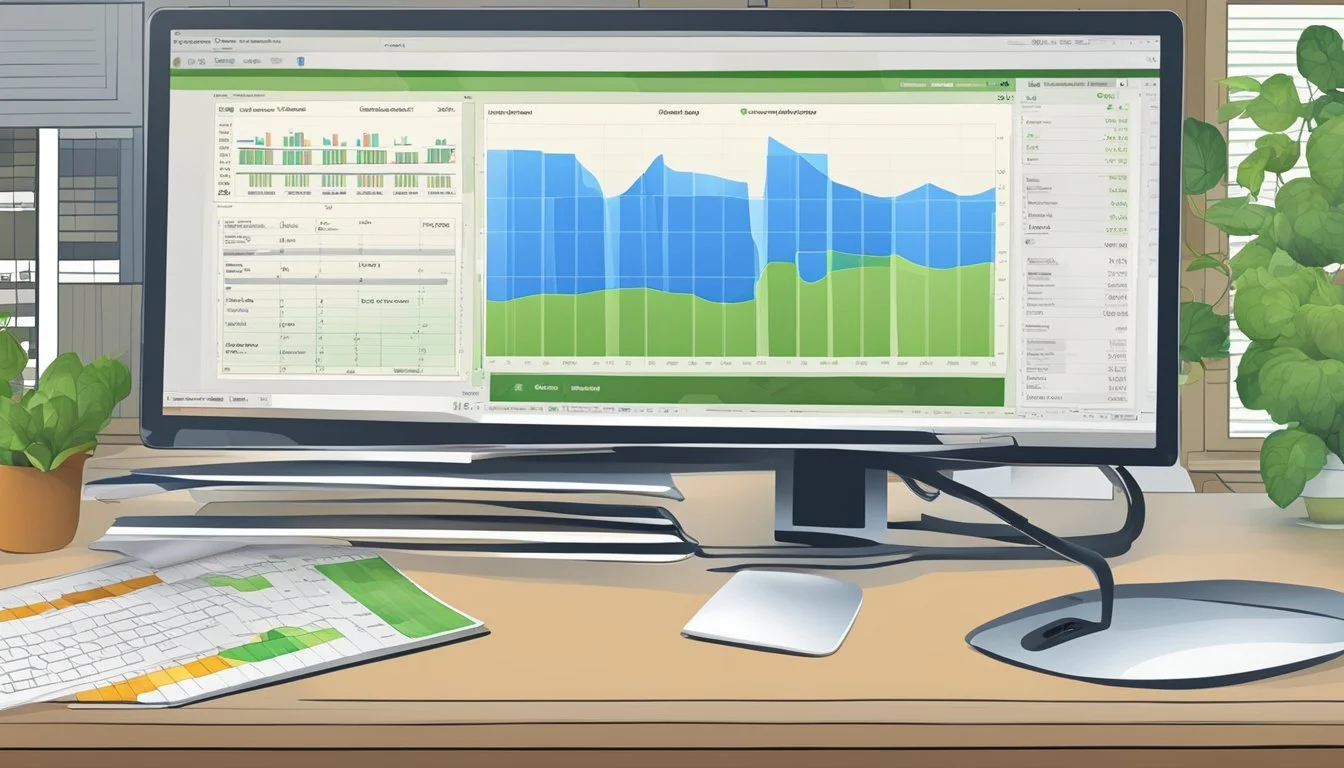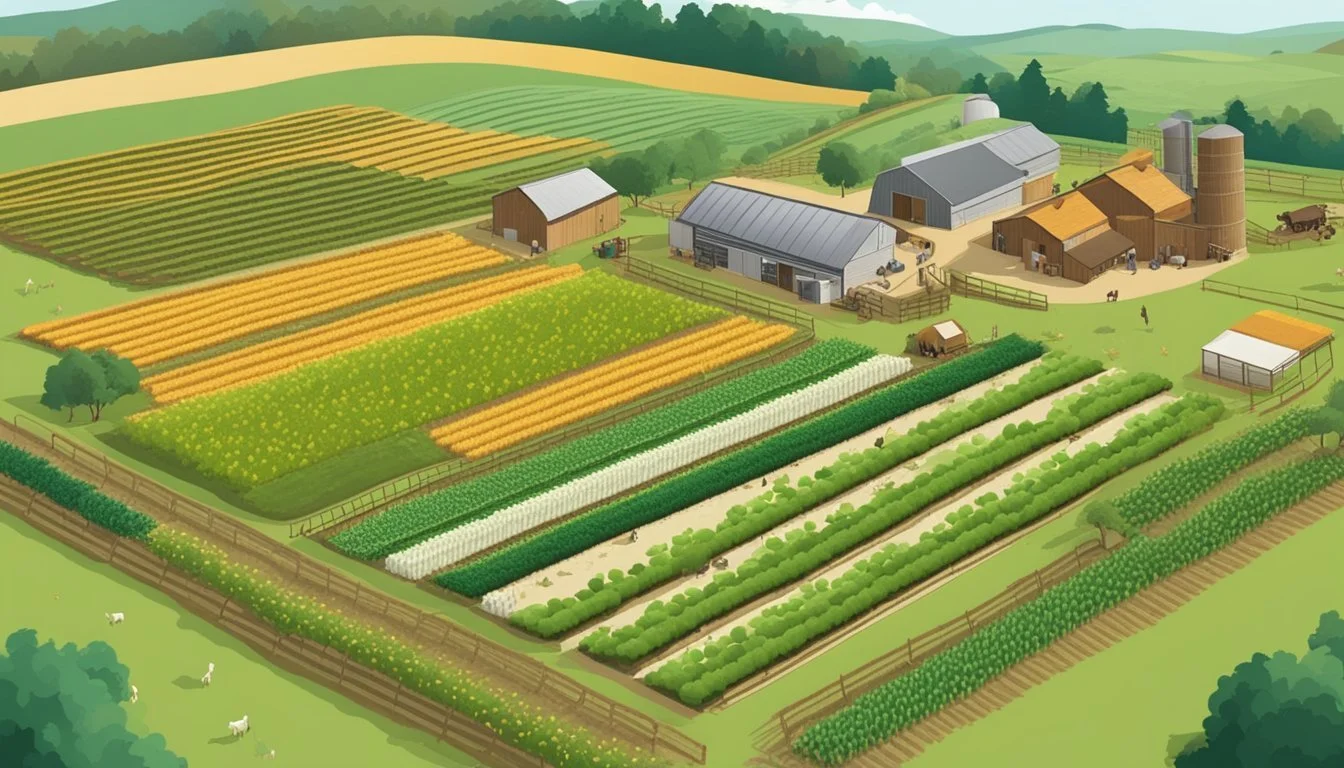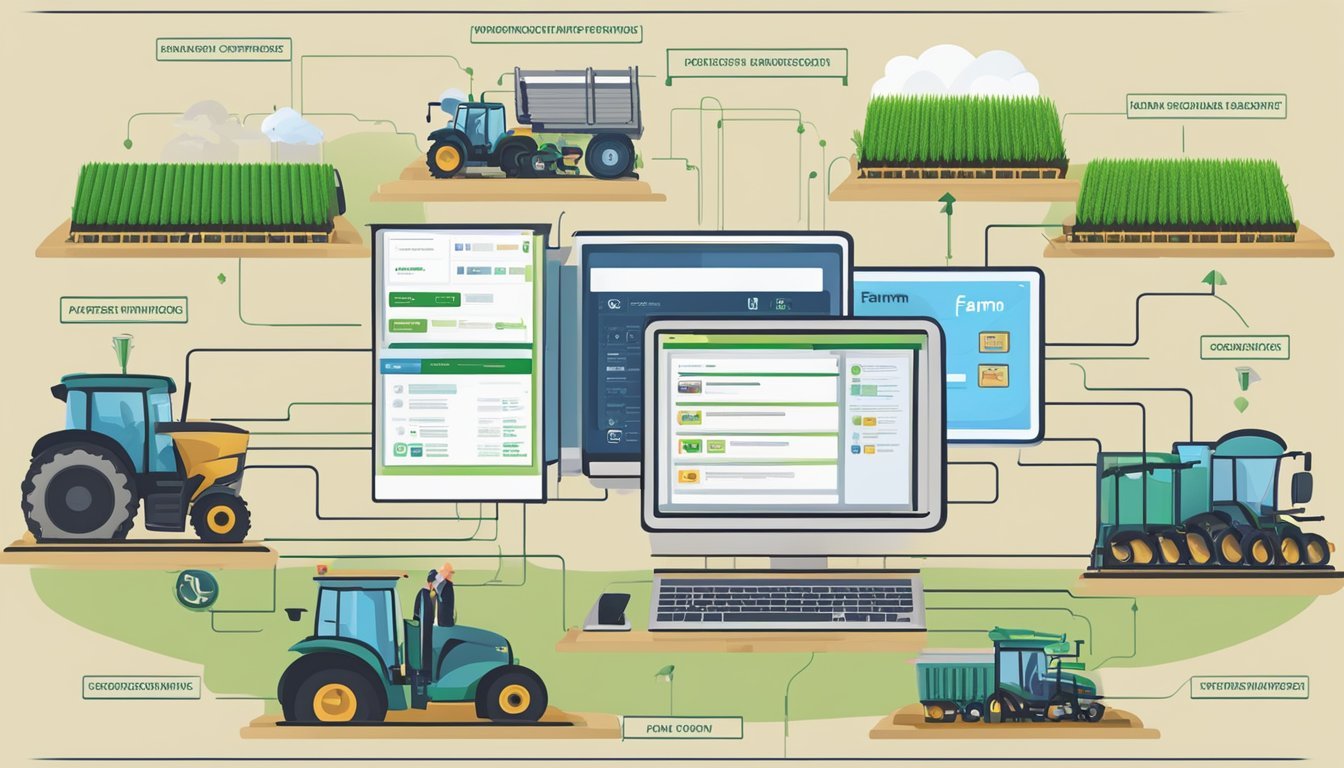The Ultimate Guide to Farm Management Software
Streamline Homestead Records and Planning
In the realm of homesteading, efficient farm management is pivotal for sustainability and growth. Farm management software has emerged as an invaluable tool that enables farmers to streamline their operations through robust record-keeping and comprehensive planning. These digital solutions are designed to replace traditional pen and paper methods, providing a centralized platform for tracking every facet of farm activity from livestock management to crop planning.
With the agricultural industry embracing technology, these software systems offer an array of features that cater to the multifaceted demands of a modern homestead. Features such as yield forecasting, field activity tracking, and farm operations data management are integral for making informed decisions. Inventory management, waste, water usage tracking, and financial analysis tools embedded within the platforms further enhance the efficiency of farm management by providing real-time insight into resource allocation and profitability.
Homesteaders seeking to optimize their operations can leverage farm management software to ensure traceability, oversee crop growth, and sustainably manage their resources. By adopting these digital systems, farmers are equipped to anticipate the needs of their operations, mitigate risks, and chart a course for future development with precision and confidence.
Fundamentals of Farm Management Software
Farm management software is an essential tool that empowers farmers to streamline their agricultural operations. These comprehensive solutions cater to various tasks, such as livestock management, yield forecasting, and inventory control. They are designed to be easy to use, often functioning on multiple devices including smartphones and tablets, ensuring accessibility even in the field.
The core attributes of such software typically include:
Record Keeping: Modern farm software provides robust record-keeping tools that allow for detailed tracking of daily activities, from planting to harvesting.
Farm Mapping: Users can create detailed maps of their fields, which is instrumental in planning and executing farm activities. This feature is also crucial for maintaining organic certifications.
Task Management: Schedulers within the apps enable efficient work management, helping farmers organize and prioritize their tasks.
Yield Tracking: These systems offer features to track and project yields, which are vital for planning and profitability assessments.
Most farm management systems are web-based, allowing for real-time data management and ease of access across various devices. The intuitive nature of these platforms means they do not require extensive technical knowledge, making them suitable even for those less familiar with advanced technologies.
With these fundamentals in place, farm management software functions as a pivotal asset for homesteaders looking to harness data for informed decision-making and enhanced operational efficiency. They blend the traditional aspects of farming with modern technology, ultimately contributing to a more sustainable and profitable agricultural enterprise.
Leveraging Software for Effective Record Keeping
Effective record keeping through farm management software provides a structured approach to data management and storage, ensuring adherence to compliance and reporting requirements, and maintaining accurate inventory tracking. Each subsection explores these aspects in detail.
Data Management and Storage
Farm management software acts as a centralized database where farm records are securely stored and easily accessible. These advanced systems allow for the recording and analysis of field activities, livestock data, and yield forecasting. They enable farmers to make precise decisions based on historical and real-time data.
Key actions involve:
Inputting daily operations data
Storing soil sampling results
Tracking crop growth and yield
Compliance and Reporting
Regulatory requirements demand meticulous record keeping to ensure farms meet compliance standards, which can be streamlined through software. Compliance reporting is built into the farm management systems, allowing for accurate and timely submissions.
Features include:
Automated reporting for organic certifications
Geotagged activity logs
Integrated compliance checklists
Inventory Tracking
Effective inventory management is crucial for maintaining the balance between supply chain demands and operational efficiency. Record-keeping software includes inventory and supply chain systems, allowing for the real-time tracking of farm supplies, equipment, and product stock levels.
Inventory management tasks:
Monitoring feed, seed, and fertilizer quantities
Updating equipment service records
Recording birth and death rates in livestock
By implementing sophisticated farm management software, homesteaders can enhance their farm's efficiency and planning capabilities, establishing robust and reliable record-keeping practices.
Strategic Planning and Analysis
Strategic planning and analysis are the bedrocks of successful farm management. Effective planning ensures optimal crop and livestock production, while thorough analysis aids in maintaining healthy financials and predicting market trends.
Crop and Livestock Planning
In crop and livestock planning, a homesteader must consider the lifecycle of each plant and animal. Crop planning involves selecting appropriate species that match the local climate and soil conditions, scheduling planting, and harvesting to maximize yield. It should integrate field activity tracking and waste and water usage management to sustain resources. For livestock, key considerations include breeding schedules, feed management, and health monitoring to ensure both productivity and animal welfare.
Key Elements:
Crop selection based on environmental factors
Livestock breeding and health schedules
Financials and Budgeting
Financial management demands precise record-keeping of all farm transactions. Homesteaders should monitor their cash flow, manage farm records systematically, and keep detailed budgets for operational costs, labor, equipment, and inputs. Profit and loss software specialized for agribusiness can provide invaluable insights into a farm’s financial health, thus guiding budget allocation and enhancing profitability.
Budget Categories:
Operational costs
Labor and wages
Equipment maintenance and purchase
Input costs (seeds, feed, fertilizer)
Forecasting and Market Analysis
Forecasting involves using historical data and current trends to make informed predictions about crop production and sales. Homesteaders benefit from yield forecasting systems that suggest when to sell crops or livestock at the best prices. Market analysis supports this by offering insights into supply and demand, helping farmers align their production with market needs to avoid surpluses and shortages that could impact revenue.
Forecasting Tools:
Yield projections based on historical data
Market trend reports to anticipate demand
Enhancing Farm Operations
Effective farm management software significantly optimizes agricultural operations by providing precise field mapping, facilitating breeding and grazing schedules, and ensuring optimal resource utilization. The incorporation of these functionalities into homesteading practices leads to a more structured and productive workflow.
Field Mapping and Management
Farm management software integrates field mapping to offer a comprehensive view of farmland areas. It helps track field activities such as:
Seeding
Harvesting
Soil sampling
With GPS field mapping reports, farmers can manage their land more efficiently by having access to real-time data for each plot, which assists in making informed decisions regarding seed placement and crop rotation strategies.
Breeding and Grazing Schedules
The software assists in managing livestock by keeping breeding schedules and tracking optimal grazing patterns. For instance:
Breeding Schedule:
Cows: AI on 05/01/2024, Expected calving on 02/01/2025
Sheep: Ram introduced on 06/15/2024, Lambing starts 11/15/2024
Grazing Schedule:
Field A: Graze from 04/01 to 05/15
Field B: Graze from 05/16 to 06/30
By ensuring these schedules are meticulously followed, farmers can enhance the reproductive efficiency of their livestock and maintain the health of their pastures.
Resource Utilization
Optimizing resource utilization is critical for sustainable farming. Key resources such as water, fertilizer, and feed are managed to avoid waste. The software aids in:
Tracking inventory levels
Forecasting future resource needs
Monitoring water usage and waste
Through effective management of these resources, farm operations become more cost-effective and environmentally responsible.
Optimization of Crop and Livestock Management
Efficiency in crop and livestock management is pivotal for the profitability and sustainability of homesteading. Farm management software has become an indispensable tool for optimization, assisting in the precise tracking and planning of agricultural activities.
Crop Protection and Disease Management
Crop management software equips farmers with tools to monitor and protect crops from diseases and pests. Through detailed record-keeping, these systems can identify patterns in disease outbreaks and suggest preventative measures. Integrated maps and weather forecasts allow for timely application of fungicides and pesticides, minimizing potential damage to crops.
Disease Tracking: Log individual incidents and apply predictive analytics.
Pest Control: Schedule and monitor pesticide applications with precision.
Livestock Health and Genetics
When it comes to livestock management, the focus on health and genetic optimization is critical. Software solutions provide features for tracking genetic information, mating schedules, and veterinary records. This ensures a high-quality gene pool and helps homesteaders make informed breeding decisions to enhance livelihood resilience and productivity.
Health Records: Store and analyze health data for timely interventions.
Genetic Profiles: Manage breeding programs based on robust genetic data.
Harvesting and Yield Management
Effective harvesting practices and yield performance measurement are crucial in evaluating the success of crop production. Farm management tools can optimize harvest schedules, track yield data, and analyze performance trends. They enable farmers to make data-driven decisions to refine sowing, irrigation, and fertilization for future cycles.
Harvest Scheduling: Allocate resources effectively based on harvest timelines.
Yield Tracking: Assess and compare yield data to inform future practices.
Farm Business and Sales Enhancement
Enhancing the efficiency of a farm business involves integrating robust farm management software aimed at streamlining ecommerce and direct sales, optimizing farm accounting for revenue tracking, and engaging customers to expand market reach.
Ecommerce and Direct Sales
Farm management systems now include ecommerce platforms, enabling farmers to directly market and sell products to consumers. These platforms facilitate inventory management, order processing, and payment transactions, all synchronized for seamless operation. Direct sales serve as a significant profit maximizer by eliminating middlemen and fostering direct relationships with customers.
Accounting and Revenue Tracking
Efficient farm accounting software is vital for financial health and informed decision-making in any farm enterprise. These systems provide tools for revenue tracking, managing expenses, and generating financial reports, thereby contributing to a comprehensive view of the farm’s profitability. They often include features like balance sheets, profit and loss statements, and cash flow analysis, ensuring that farmers have real-time access to their financial data.
Customer and Market Engagement
To boost sales and business growth, farms need to engage with their customer base and understand market trends. Advanced software aids in collecting and analyzing customer feedback, managing customer relationships, and monitoring market demands. These insights help farms to tailor their products to customer preferences and strategically plan marketing efforts, leading to enhanced customer satisfaction and higher sales volumes.
Resource and Inventory Management
Effective management of resources and inventory is crucial for homestead farmers. Detailed tracking systems help maintain a clear overview of machinery, seeds, and soil health, optimizing farm operations.
Machinery and Equipment Tracking
Tracking machinery and equipment ensures that farmers are aware of maintenance needs and service histories, reducing unexpected repairs. A typical farm management software may feature:
Service Records: List of maintenance dates, costs, and service types.
Usage Logs: Hours of operation and tasks performed by each machine.
Seed and Fertilizer Inventory
Accurate record-keeping of seed and fertilizer inventory aids farmers in planning and ensures timely applications, preventing shortages. Inventory management within software often includes:
Stock Levels: Current quantities of various seeds and fertilizers.
Usage Rates: Historical data on usage per crop cycle or acreage.
Soil Health and Testing
Soil testing data is integral for informed decisions on land management and fertilizing practices. Farm management software can help record and analyze:
Test Results: Key metrics such as pH levels, nutrient content, and organic matter.
Recommendations: Fertilizer types and quantities tailored to soil conditions.
Technology Integration and Farm Automation
In the realm of homesteading, the fusion of sophisticated software with cutting-edge hardware paves the way for enhanced farm management. By leveraging the latest in technology, homesteaders can automate processes, refine data collection, and make data-driven decisions.
IoT and Smart Devices
Internet of Things (IoT) devices are crucial in collecting farm data. From soil sensors to climate control systems, these devices gather precise information in real-time. They fulfill diverse functions:
Soil Moisture Sensors: Monitor hydration levels to optimize irrigation.
Livestock Trackers: Keep health and location data on farm animals.
Climate Control: Regulate greenhouse temperatures remotely.
This immediate access to data allows for rapid response and adaptation to changing farm conditions, thereby enhancing efficiency and potentially increasing yields.
Satellite Imagery and Drone Mapping
Satellite imagery and drone mapping technologies have revolutionized farm mapping. Homesteaders utilize these tools to gain aerial perspectives that inform a range of decisions:
Identifying crop vigor and problem areas
Mapping out farm infrastructure for better planning
Tracking changes over time to observe trends
Drone mapping, in particular, offers high-resolution images and can cover areas that satellites may not, thus providing a complementary layer of data analysis.
Software Development and Customization
Tailored software solutions are increasingly accessible thanks to software developers crafting applications specific to the needs of a farm. Customization can address unique aspects such as:
Specific crop management workflows
Integration with existing hardware or software systems
Localized reporting requirements for agriculture compliance
The development of such software ensures that the full spectrum of farm management needs is met, from financial tracking to precision agriculture decision-support systems. Custom solutions mean that software can grow with a homestead, aligning with both current and future needs.
Comprehensive Software Solutions
In the realm of homesteading, comprehensive software solutions facilitate meticulous record-keeping and strategic planning. These tools offer a range of functionalities designed to streamline farm management tasks.
Leading Software Platforms
Several software platforms have emerged as leaders in farm management. Farmbrite stands out for its robust record-keeping and traceability features. It enables farmers to plan crops and track growth, with the added benefit of helping with organic certifications. FarmLogic offers a web-based system, excelling in service records and soil sampling, alongside GPS field mapping capabilities.
Agrivi is well-regarded for its yield forecasts and farm operations data management, while FarmLogs provides a suite of tools for inventory and supply chain management. Larger operations may turn to Granular, which specializes in high-level data analysis and financial oversight. Conservis integrates multiple aspects of farm management into one platform, focusing on efficiency and real-time data tracking.
Agworld simplifies collaboration through its software, aligning different farm tasks with operational strategy, and Croptracker is notable for its attention to detail in both yield projections and waste management.
All-In-One Software Benefits
All-in-one software solutions, like those offered by some platforms, oftentimes feature:
Streamlined Operations: A centralized system for all farm management tasks, from planning to profit/loss tracking.
Enhanced Decision-Making: Real-time data and analytics improve the farmers' ability to make informed choices.
Risk Management: Systems like Conservis allow for better risk assessment and management through detailed record-keeping.
Time Saving: Integrated tools reduce the time spent on administrative tasks, offering more time for on-ground farming activities.
Choosing the Right Farm Software
When selecting the appropriate farm management software, it is important to consider the following aspects:
Specific Farm Needs: Does the software cater to crop farming, livestock management, or both?
Software Scalability: Can the platform grow with your farm's operations? Solutions like Granular can handle scaling needs.
Ease of Use: Consider the learning curve associated with platforms like Agworld or FarmLogic, ensuring that they are user-friendly.
Support and Development: Investigate whether platforms like Farmbrite or Agrivi offer continuous support and software updates.
By carefully evaluating these factors, homesteaders can ensure they invest in a platform that aligns with their current and future farm management needs.
Maintaining Compliance and Certifications
Farm management software has become a pivotal tool in ensuring that homesteaders remain compliant with regulations and maintain necessary certifications. Proper record-keeping and data management systems are at the heart of this process, enabling farmers to streamline compliance reporting and adhere to organic and environmental standards.
Organic and Environmental Standards
Homesteaders often pursue organic certification to establish the credibility of their products and adhere to environmental standards. Farm management software aids in maintaining detailed records that are essential for certification, such as pesticide usage, fertilizer types, and soil management practices. These platforms support farmers in tracking and proving their commitment to sustainable and chemical-free farming practices.
Key Records for Organic Certification:
Pesticide and fertilizer application logs
Soil management and crop rotation details
Seed sources and planting dates
Government Regulations and Audits
Remaining in compliance with government regulations is not only about avoiding penalties but also about ensuring the long-term sustainability of the farm. Farm management software supports homesteaders in preparing for audits by providing organized and accessible records. These digital solutions facilitate compliance reporting by automatically updating with the latest state and federal agricultural regulations.
Compliance Elements:
Audit Trail: Easily accessible, timestamped records of farm activities.
Regulatory Updates: Notifications of changes in legislation affecting farm operations.
Traceability and Seed-to-Sale Tracking
Traceability is crucial in today’s agricultural landscape, especially for homesteaders who need to monitor their products from seed to sale. Farm management software enables tracking of each batch of produce, ensuring seed-to-sale compliance. It allows producers to swiftly recall products, if necessary, enhancing consumer trust and safety.
Traceability Components:
Batch Numbers: Assigning and tracking batch numbers for produce.
Sales Records: Detailed histories of product sales and distribution channels.
By utilizing farm management software for record-keeping and planning, homesteaders are empowered to maintain industry standards, ensure regulatory compliance, and provide transparency in their farming practices. This not only strengthens marketability but also reinforces the integrity of their homesteading operations.
Advanced Techniques and Specialized Farming
In the realm of homesteading, employing advanced farming techniques that focus on specialized farming can boost productivity and sustainability. Innovative systems that carefully balance environmental needs with agricultural demands provide a path forward for homesteaders looking to optimize land use.
Aquaponics and Hydroponics
Aquaponics combines aquaculture and hydroponics in a symbiotic environment, enabling the cultivation of plants and aquatic animals like fish in a single system. This method conserves water and negates the need for chemical pesticides, as fish waste provides nutrients for plants, which in turn purify the water for the fish. Hydroponics, the technique of growing plants without soil, uses nutrient-rich water solutions. Both systems can substantially increase crop yield per square foot and are especially advantageous for homesteaders with limited space.
Aquaponics: An integrated system that encourages water reuse, enhances crop protection through its closed-loop ecosystem, and requires no chemical treatments.
Hydroponics: A soil-less cultivation method that allows for precise control over nutrients and environment, resulting in faster growth rates of crops.
Multi-Species and Rotational Grazing
Multi-species grazing involves the strategic rotation of different types of livestock across pastures to harness their unique grazing patterns and behaviors. This approach can improve pasture health and reduce the reliance on artificial fertilizers and chemicals. Livestock like goats, which naturally forage on weeds, can provide a natural method for managing undesired vegetation without the use of pesticides. Rotational grazing allows time for pastures to recover, leading to better forage and soil health. Farm management software can assist in planning and organizing these multi-species rotational schedules to maximize efficiency and land use.
Key Benefits:
Enhanced soil fertility and structure
Natural weed and pest control
Optimized animal health and pasture yield
Organic and Sustainable Practices
Organizational businesses in the realm of homesteading are increasingly adopting organic and sustainable farming practices. These methods focus on maintaining a healthy balance within the ecosystem without depending on synthetic inputs. Techniques include the use of natural compost, green manure, and biological crop protection methods. Such practices not only support the environment but also yield produce free from chemical residues, appealing to consumers interested in organic food.
Homesteaders can prioritize sustainable practices such as:
Minimizing non-organic waste through composting and recycling
Employing crop rotation and cover cropping to preserve soil health
Using organic treatments to enhance biodiversity and minimize ecological disruption
By integrating these advanced techniques into their farming operations, homesteaders can lead the way in ecologically responsible agriculture.
Conclusion: Building a Profitable and Sustainable Farm
In the realm of homesteading, farm management software stands as an indispensable tool for balancing profitability with sustainability. By streamlining record-keeping and fostering meticulous planning, such software enables farmers to make informed decisions that enhance efficiency and overall farm health.
Effective cost tracking plays a pivotal role in reducing overhead and bolstering the bottom line. Farmers can identify areas where expenditures can be trimmed without compromising the integrity of their operations. With detailed records, they uncover patterns and metrics essential for strategic decision-making.
The incorporation of farm management software not only aids in financial oversight but also in maintaining sustainable practices. These digital solutions advocate for the responsible use of resources, often featuring modules that support:
Crop rotation and soil health
Water conservation techniques
Energy-efficient processes
By leveraging these functionalities, farmers can adopt practices that not only cut costs but also contribute positively to the environment.
To achieve continual profitability on a homestead, it is crucial to couple strategic financial oversight with a commitment to sustainable agriculture. Farm management software bridges this gap, providing a platform for record-keeping that drives both economic and ecological resilience.
Farmers who harness the power of these digital tools find themselves at the helm of ventures where profitability and sustainability are not mutually exclusive but are mutually reinforcing facets of a successful homesteading enterprise.










